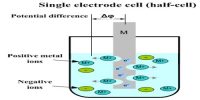The Bronsted-Lowry theory considers the proton-transfer reactions between conjugate add-base pairs. Such add-base reactions can be seen as a competition between species for hydrogen ions. From this point of view, we can order acids by their relative strength as hydrogen ion donors.
The stronger acids are those that lose their hydrogen ions more easily than other acids. Similarly, the stronger bases are those that hold onto hydrogen ions more strongly than other bases. If an acid loses it the resulting anion is in a position to re-accept a proton, making it a Breasted-Lowry base. It is logical to assume that if an acid is considered strong, its conjugate base (i.e. its anion) would be weak since it is unlikely to accept a hydrogen ion.
The position of an acid-base equilibrium will depend on the relative strengths of the species involved.
HNO3 (aq) + H2O (I) ↔ NO3– (aq) + H3O+ (aq)
Acid base base acid
In the above system, we have two opposing Breasted- Lowry acid-base reactions. HNO3 is a much stronger add than H30*, so the equilibrium lies far to the right.
Acid strength: The strength of an acid is a measure of how dissociated it is in water; or how readily it donates a proton compared to water. Note that this is not the same as how concentrated it is.
Concentration is a measure of how many moles are dissolved per dm3. However, some of these molecules may not be dissociated into IP ions. So, for example, it is possible to have a strong, dilute acid, or a weak concentrated acid.












